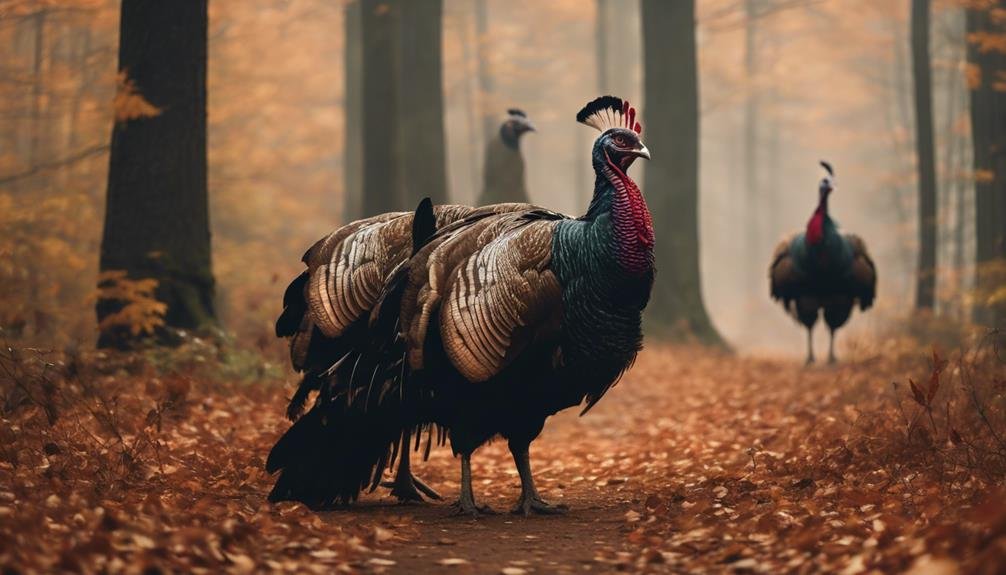Wild turkeys, comprising five distinct subspecies, have evolved to thrive in diverse geographic regions across the United States. Each subspecies exhibits unique physical characteristics, adaptations, and habitat preferences that have enabled them to reign supreme in their respective domains. The Eastern wild turkey is the most populous, with a flock size of approximately 5.3 million, whereas Merriam's turkeys inhabit western states with a significantly lower population. Rio Grande turkeys exhibit nomadic behavior, while Gould's turkeys inhabit Arizona, New Mexico, and Mexico, with the longest legs and largest feet among all subspecies. Further exploration reveals the intricate facets of these feathered kings.
Key Takeaways
- There are five distinct subspecies of wild turkeys in the United States, each adapted to its unique geographic region.
- The Eastern subspecies is the most populous, with a flock size of approximately 5.3 million, inhabiting mature forests with dense canopies.
- Each subspecies exhibits unique physical characteristics, such as the Osceola turkey's longest spurs and the Gould's turkey's light-colored fans and mountain adaptations.
- Wild turkeys inhabit various habitats, including forests, grasslands, agricultural lands, and urban fringes, with each subspecies adapted to its native environment.
- Conservation efforts are essential to address habitat loss, fragmentation, and climate disruptions that threaten wild turkey populations and genetic diversity.
Turkey Subspecies Across America
Across the United States, five distinct subspecies of wild turkeys have evolved to thrive in diverse geographic regions, each with unique characteristics that have adapted to their respective environments. The Eastern subspecies, found in states east of the Missouri River, is the most populous, with a flock size of approximately 5.3 million. In contrast, Merriam's turkeys inhabit states west of the Missouri River, with a notably lower population due to predators and habitat limitations. Rio Grande turkeys, found in the central and western regions, exhibit nomadic behavior, while Gould's turkeys inhabit Arizona, New Mexico, and Mexico, with the longest legs and largest feet among all subspecies. Osceola turkeys, exclusive to Florida, boast the longest spurs. Understanding these subspecies and their habitats is vital for effective turkey migration management and state regulations.
Eastern Turkey Characteristics
The Eastern wild turkey, the most abundant subspecies in the United States, exhibits distinct physical and behavioral characteristics that have adapted to its eastern habitat. These birds are the heaviest of all turkey subspecies, with weights regularly exceeding 25 pounds. Their Eastern behavior is marked by a dominant male, which asserts its Turkey dominance through loud, booming gobbles and impressive displays of plumage. The Eastern turkey's copper to bronze tail fan is a distinguishing feature, and their long beards and spurs are a hallmark of their adaptation to their environment. With a population of over 5.3 million, the Eastern wild turkey is a true king of the American wilderness, thriving in its eastern habitat.
Merriam's Turkey Habitat and Size
Merriam's turkeys occupy a vast range of habitats, from scrubby deserts to mountainous forests, with their populations dispersed across the western United States. They thrive in the rugged mountain terrain, where their agility and adaptability allow them to navigate steep slopes and fragmented forests. Forest fragmentation, resulting from human activities and natural processes, has created a mosaic of habitats that Merriam's turkeys have learned to exploit. Their ability to thrive in these environments is a demonstration of their resilience and resourcefulness. With a smaller size compared to Eastern turkeys, Merriam's turkeys typically weigh between 10-15 pounds, making them well-suited to their western habitats. Their smaller size allows them to exploit resources in these fragmented landscapes, ensuring their survival in this diverse range of habitats.
Rio Grande Turkey Distribution
Rio Grande turkeys fan out across the Great Plains, their range stretching from North Dakota to Hawaii, with a primary stronghold in the southern Great Plains from Kansas to Texas and Washington to California. This subspecies has a rich history, with evidence of ancient turkey migrations dating back to the Pleistocene era. Their distribution is influenced by food availability, climate, and human activities.
| State | Population |
|---|---|
| Texas | 600,000 |
| Kansas | 300,000 |
| California | 200,000 |
| Washington | 100,000 |
Rio Grande turkeys are known for their nomadic behavior, often traveling long distances in search of food and suitable habitats. Understanding their distribution patterns is essential for effective conservation and management strategies.
Gould's Turkey Identifying Features
Gould's turkeys, found in Arizona and New Mexico, are most easily identified by their light-colored fans, with tailfeathers that are nearly snow white. These unique features set them apart from other turkey subspecies. Adapted to the rugged terrain of the southwestern United States, Gould's turkeys have developed distinct mountain adaptations, enabling them to thrive in the region's harsh environment. Their habitat ranges from the Border ranges of Arizona to the mountainous regions of New Mexico, where they inhabit areas with steep terrain and limited vegetation. These specialized adaptations have allowed Gould's turkeys to flourish in their native range, making them a unique and fascinating subspecies.
Osceola Turkey Hunting Tips
When pursuing Osceola turkeys in Florida, hunters should be prepared to adapt their strategies to the unique characteristics of this subspecies, which has evolved to thrive in the state's diverse landscape of open pastures, palmetto hammocks, and pine timber stands. Florida habitats, characterized by dense vegetation and scattered water sources, require a nuanced approach to decoy placement and calling techniques. Effective decoy strategies involve using realistic setups that mimic the social dynamics of Osceola flocks, often featuring multiple hens and a dominant tom. Hunters should also be prepared to move quietly and efficiently through the dense Florida habitats, using the terrain to their advantage to get within range of their quarry. By understanding the Osceola's habits and adapting to its environment, hunters can increase their chances of success in the Sunshine State.
Turkey Weight and Plumage Variations
Among the various subspecies of wild turkeys in America, one of the most striking variations is the range of weights and plumage characteristics that distinguish each group. From the heavyweights like the Eastern subspecies, which can exceed 25 pounds, to the more slender Merriam's and Rio Grande turkeys, weight differences are notable. Plumage variations are equally striking, with notable differences in feather iridescence and color morphs.
- Eastern turkeys: Copper to bronze tail fans, with weights exceeding 25 pounds.
- Merriam's turkeys: Buff-colored tail feathers, with a quieter gobble and lighter weight.
- Rio Grande turkeys: Tan-colored tail feathers, with medium-sized beards and spurs.
These physical differences not only distinguish each subspecies but also have important implications for hunting strategies and habitat preferences.
Beard and Gobble Characteristics
Turkeys' beard and gobble characteristics, which vary markedly across subspecies, play a pivotal role in their social dynamics and mating behaviors. The Eastern subspecies boasts the longest beards and loudest gobbles, while Merriam's turkeys have the quietest gobble and shortest beards. Rio Grande turkeys have medium-sized beards, and Gould's turkeys are identified by their light-colored fans. Osceola turkeys are known for their booming gobbles. Turkey calls, including the distinctive gobble tone, serve as a crucial form of communication among turkeys. The intensity and frequency of these calls can indicate dominance, attract mates, or signal alarm. By understanding these characteristics, hunters and wildlife enthusiasts can better appreciate the complex social structures and behaviors of wild turkeys.
Turkey Spurs and Leg Size
In the domain of turkey anatomy, the size and shape of spurs, along with leg size, serve as important distinguishing characteristics among the various subspecies. Turkey leg strength is vital for survival, enabling them to escape predators and forage for food. Spurs, located on the legs, are made of keratin and can be measured using techniques such as caliper measurements or digital imaging.
Three key points are noted:
- Spur length: Measured from the base of the spur to the tip, this can range from 1 to 2 inches (2.5 to 5 cm) depending on the subspecies.
- Leg circumference: This can vary substantially between subspecies, with some reaching up to 5 inches (13 cm) in circumference.
- Spur shape: Spurs can be curved, straight, or hooked, and their shape can be an identifying feature of a particular subspecies.
Habitat and Roosting Patterns
Wild turkeys occupy a diverse range of habitats across North America, from forests and grasslands to agricultural lands and urban fringes, with each subspecies exhibiting unique adaptations to its native environment. The Eastern subspecies, for instance, thrives in mature forests with dense canopies, often roosting in tree canopies up to 60 feet above ground. In contrast, Merriam's turkeys inhabit open forests and grasslands, where they roost on forest edges or in tree-lined draws. Rio Grande turkeys, meanwhile, favor open agricultural lands and urban fringes, roosting in trees or on power lines. Understanding these habitat and roosting patterns is essential for effective conservation and management of wild turkey populations.
Conservation Status and Threats
Habitat loss and fragmentation, exacerbated by human activities, have profoundly impacted wild turkey populations, rendering conservation efforts imperative to guarantee the long-term sustainability of these iconic birds. The cumulative effects of habitat degradation, fragmentation, and climate disruptions have led to population declines and reduced genetic diversity.
Three key threats to wild turkey populations are:
- Habitat fragmentation, which isolates populations and reduces gene flow.
- Climate disruptions, which alter food availability and breeding patterns.
- Human-turkey conflicts, which arise from encroachment into agricultural lands and urban areas.
Addressing these threats through conservation efforts, such as habitat restoration and connectivity projects, is essential to ensuring the long-term viability of wild turkey populations.
Frequently Asked Questions
Can Domesticated Turkeys Interbreed With Wild Turkeys?
Domesticated turkeys can interbreed with wild turkeys, producing hybrid offspring with potential genetic implications, as their genetic material can introgress into wild populations, altering the genetic integrity of native species.
How Do Turkeys Protect Themselves From Natural Predators?
Turkeys employ adaptive defense mechanisms, such as flocking behavior to overwhelm predators, and camouflage strategies, including plumage blending and freeze responses, to protect themselves from natural predators, ensuring survival in their native habitats.
Do Turkeys Have a Strong Sense of Smell or Hearing?
Turkeys possess a relatively weak sense of smell, with olfactory abilities limited to detecting strong scents, whereas their auditory range is exceptional, with acute hearing that enables detection of subtle sounds, facilitating early predator detection and evasion.
Can Turkeys Swim, and if So, How Well?
In a study, a wild turkey was observed swimming across a 100-meter lake, demonstrating its ability to swim. Turkeys' feather buoyancy, combined with their powerful legs and webbed feet, enables them to navigate water with ease, making them capable waterfowl.
Are Wild Turkeys Known to Form Long-Term Pair Bonds?
Wild turkeys do not form long-term pair bonds; their mating habits are characterized by polygynous relationships, where dominant males mate with multiple females, and social bonds are primarily focused on hierarchical dominance rather than pair bonding.
Conclusion
In summary, the diverse subspecies of wild turkeys across America showcase a tapestry of unique characteristics, habitats, and adaptations. As the sun sets on a forest glade, can the rustling of leaves and snapping of twigs be the only signs of a turkey's presence, leaving the observer to wonder: do these feathered kings still reign supreme in their domains, or are they mere whispers of a bygone era?









